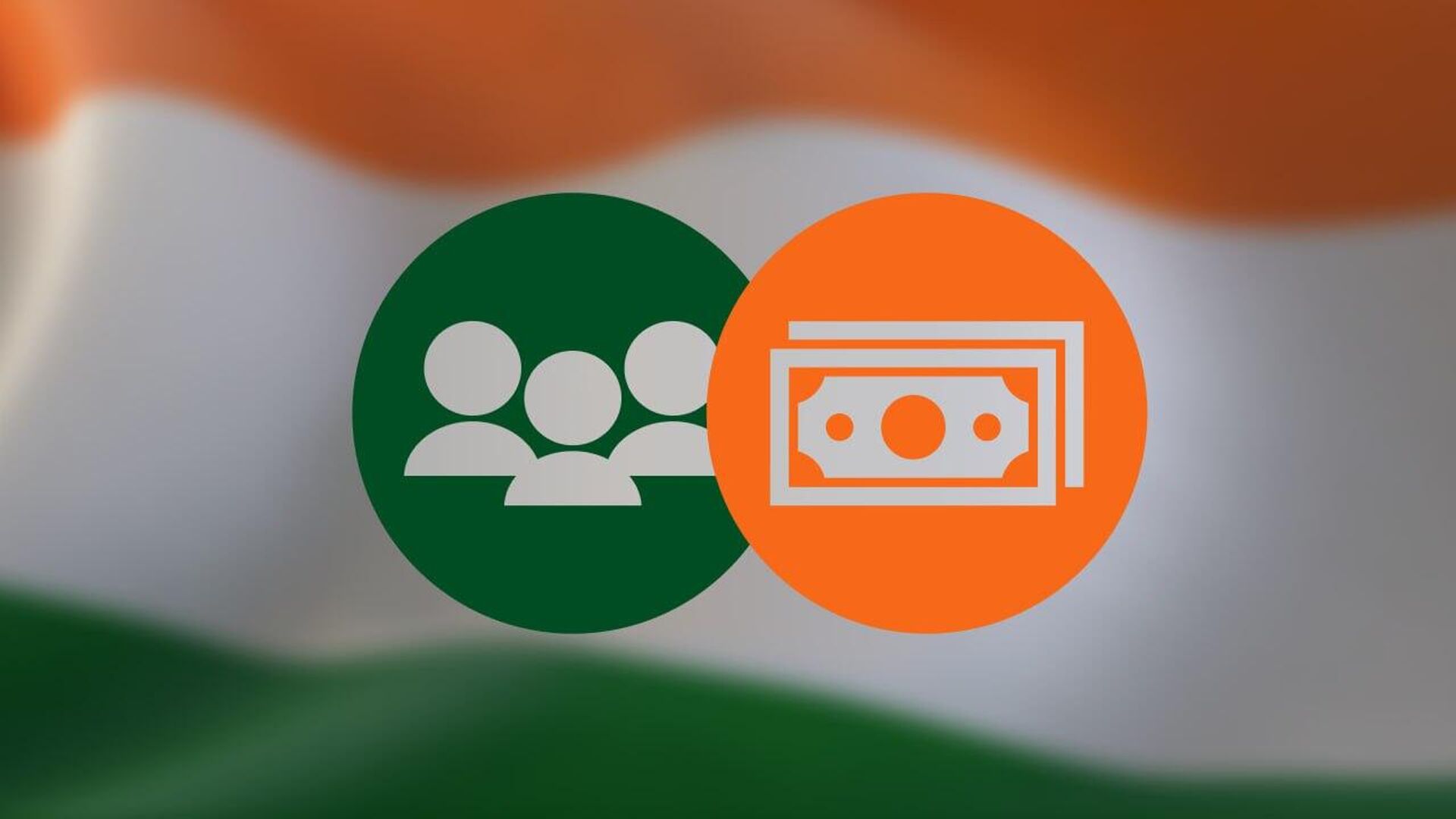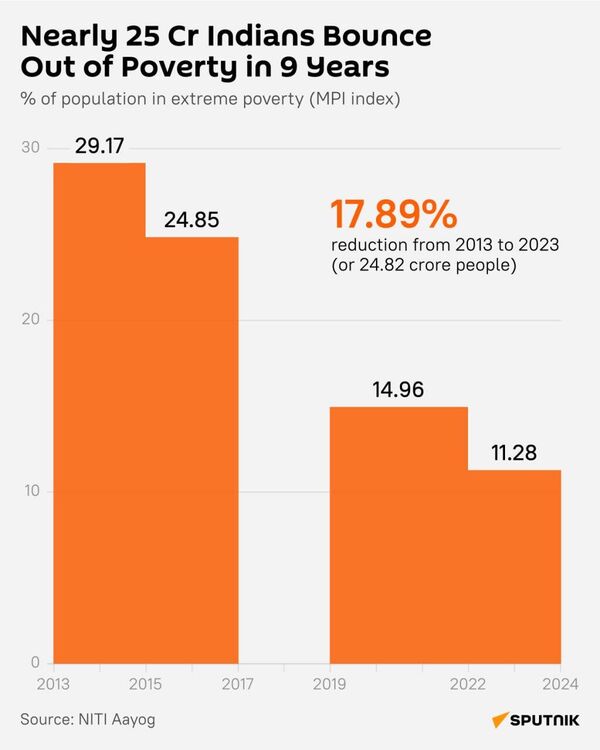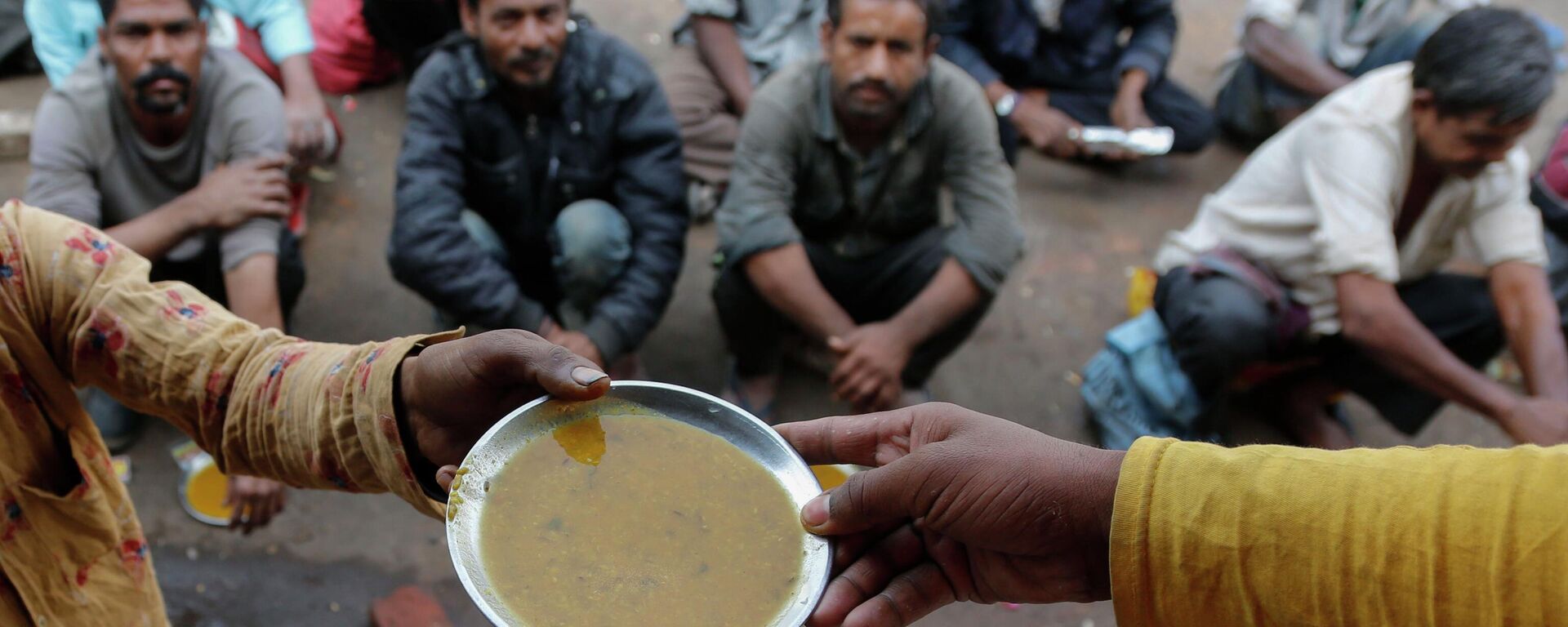https://sputniknews.in/20240116/what-led-250-million-indians-break-free-from-poverty-in-9-years-6218904.html
What Led 250 Million Indians Break Free from Poverty in 9 Years?
What Led 250 Million Indians Break Free from Poverty in 9 Years?
Sputnik India
In a recent report by NITI Aayog, as many as 24.82 crore Indians moved out of multidimensional poverty in the past nine years, especially in Uttar Pradesh, Bihar, and Madhya Pradesh states.
2024-01-16T17:53+0530
2024-01-16T17:53+0530
2024-01-17T12:40+0530
india
nitish kumar
bihar
uttar pradesh
madhya pradesh
poverty
welfare schemes
fraud scheme
free food scheme
sputnik opinion
https://cdn1.img.sputniknews.in/img/07e8/01/10/6224741_0:0:1280:720_1920x0_80_0_0_c71249b2f111510a9f25bf53bff8656b.jpg
India has made significant progress in reducing multidimensional poverty, with a remarkable decline from 29.17% in 2013-14 to 11.28% in 2022-23, according to a report by Niti Aayog.The data indicates a substantial reduction of 17.89%, leading to as many as 248.2 million people being lifted out of poverty during this period.Uttar Pradesh leads the way with an astounding 59.4 million people breaking free from poverty, followed by Bihar in second place with 37.7 million people, and Madhya Pradesh with 23 million people.Dr. Kumar's insights told Sputnik India that the improvement in the multi-dimensional poverty could largely be attributed to advances in nutrition, years of schooling, sanitation, and cooking fuel."The government initiatives to increase access to formal sources of finances through JAM (Jan Dhan Yojana, Aadhaar and Mobile number) initiatives have also contributed to an overall improvement in the index," he added.To further reduce the prevalence of poverty across states, it will require additional efforts by the central and state governments."Initiatives like aspirational districts and block programmes are expected to help people improve on the indicators listed in the multi-dimensional poverty index," he concluded.
https://sputniknews.in/20230717/india-lifted-record-135-million-people-from-poverty-in-five-years-niti-aayog-3042055.html
india
bihar
uttar pradesh
madhya pradesh
Sputnik India
feedback.hindi@sputniknews.com
+74956456601
MIA „Rossiya Segodnya“
2024
Sangeeta Yadav
https://cdn1.img.sputniknews.in/img/07e6/0c/0f/110602_0:0:641:640_100x100_80_0_0_c298016a79eb02ef8caa9d1f688c12a5.jpg
Sangeeta Yadav
https://cdn1.img.sputniknews.in/img/07e6/0c/0f/110602_0:0:641:640_100x100_80_0_0_c298016a79eb02ef8caa9d1f688c12a5.jpg
News
en_IN
Sputnik India
feedback.hindi@sputniknews.com
+74956456601
MIA „Rossiya Segodnya“
Sputnik India
feedback.hindi@sputniknews.com
+74956456601
MIA „Rossiya Segodnya“
Sangeeta Yadav
https://cdn1.img.sputniknews.in/img/07e6/0c/0f/110602_0:0:641:640_100x100_80_0_0_c298016a79eb02ef8caa9d1f688c12a5.jpg
poverty, niti aayog, multidimensional poverty, millions of people in india lifted out of poverty, breaking free from poverty, economist, associate professor, bihar institute of public finance and policy, dr. sudanshu kumar, socio-economic indicators, sustainable development goals (sdg), multi-dimensional poverty, years of schooling, sanitation, cooking fuel, schemes, swachh bharat abhiyan, cleanliness, ujjwala yojna, access to clean fuel, access to formal sources of finances, jam, jan dhan yojana, aadhaar and mobile number, clean drinking water, improved electricity connection, improved employment opportunities, impoverished population, aspirational districts, block programmes
poverty, niti aayog, multidimensional poverty, millions of people in india lifted out of poverty, breaking free from poverty, economist, associate professor, bihar institute of public finance and policy, dr. sudanshu kumar, socio-economic indicators, sustainable development goals (sdg), multi-dimensional poverty, years of schooling, sanitation, cooking fuel, schemes, swachh bharat abhiyan, cleanliness, ujjwala yojna, access to clean fuel, access to formal sources of finances, jam, jan dhan yojana, aadhaar and mobile number, clean drinking water, improved electricity connection, improved employment opportunities, impoverished population, aspirational districts, block programmes
What Led 250 Million Indians Break Free from Poverty in 9 Years?
17:53 16.01.2024 (Updated: 12:40 17.01.2024) In a recent report by NITI Aayog, as many as 24.82 crore Indians moved out of multidimensional poverty in the past nine years, especially in Uttar Pradesh, Bihar, and Madhya Pradesh states.
India has made significant progress in reducing multidimensional poverty, with a remarkable decline from 29.17% in 2013-14 to 11.28% in 2022-23, according to a report by Niti Aayog.
The data indicates a substantial reduction of
17.89%, leading to as many as 248.2 million
people being lifted out of poverty during this period.
Uttar Pradesh leads the way with an astounding 59.4
million people breaking free from poverty, followed by Bihar in second place with 37.7 million people, and Madhya Pradesh with 23 million people.
"A decline in the multi-dimensional poverty index indicates an improvement in the quality of life of the people at the bottom regarding income level. It will help India achieve its target of the Sustainable Development Goals (SDG) within the set time frame of 2030," economist and Associate professor at Bihar Institute of Public Finance and Policy, Dr. Sudanshu Kumar told Sputnik India.
Dr. Kumar's insights told Sputnik India that the improvement in the multi-dimensional poverty could largely be attributed to advances in nutrition, years of schooling, sanitation, and cooking fuel.
"Schemes like Swachh Bharat Abhiyan, which focused on awareness of hygiene, and Ujjwala Yojna, aimed at providing access to clean fuel, have contributed to these improvements. There are significant improvements in terms of years of schooling across the country," Dr. Kumar said.
"The government initiatives to increase access to formal sources of finances through JAM (Jan Dhan Yojana, Aadhaar and Mobile number) initiatives have also contributed to an overall improvement in the index," he added.
From access to clean drinking water through various state and central government schemes to improved electricity connection, these indicators have also helped people get out of poverty, Dr. Kumar added.
"With the people least worried about the lack of basic necessities, they can improve their skills and contribute to economic growth," Dr. Kumar said.
To further reduce the prevalence of poverty across states, it will require additional efforts by the central and state governments.
"Initiatives like aspirational districts and block programmes are expected to help people improve on the indicators listed in the multi-dimensional poverty index," he concluded.





